How to kill English ivy
No offense to the English, but please get out of my yard. Here in the United States, English ivy plants are an unwelcome invasive species. It has been the bane of my existence for the last 12 years while trying to transform our North Carolina yard to native species. I’ve spent many years trying to figure how to kill ivy without herbicides because we don’t want to add poisons to our yard. Some things have worked, some haven’t. Here are some tips on how to kill English ivy infestations in your yard before it kills everything else.

Is English ivy invasive?
Why bother removing English ivy? Is English ivy invasive? Yes it is! According to the USDA, English ivy (Hedera helix) is highly invasive outside of its native range, including here in the US. This evergreen vine grows extremely fast, creeping along at ground level and up trees into the canopy. It outcompetes and drowns out native ground cover plants and shades saplings from receiving sunlight. In our yard it creates an impenetrable layer on the forest floor allowing few native plants to survive, even creeping across our pollinator garden. Occasionally, birds use English ivy berries as a food source and spread them further, but keep in mind they are poisonous to humans!
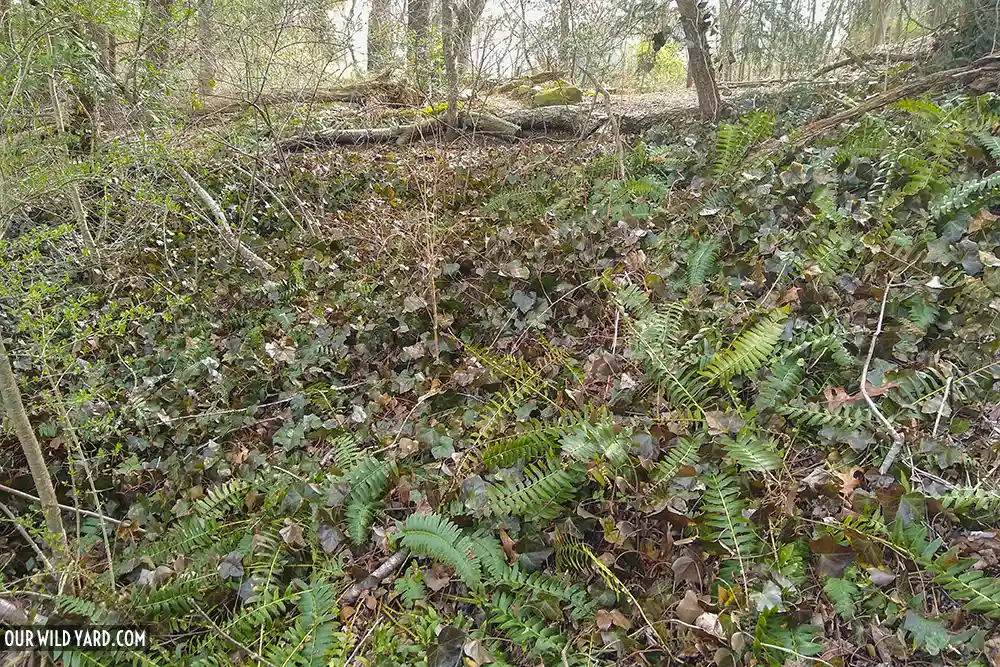
Will English ivy kill a tree?
Yes! English ivy will kill a tree. It climbs rapidly up a tree trunk, attaching firmly to the tree’s bark. Eventually it will reach the canopy and spread out, blocking sunlight with its evergreen leaves and decreasing the tree’s ability to photosynthesize. It can also cause structural damage by adding excessive weight and making them more likely to blow over in high winds or to break during ice and snow storms. We are always shocked by how high it can climb mature trees in a single year if left unattended.

How to kill ivy without the use of herbicide
It may be tempting to dump a systemic herbicide on the green menace in your yard, but keep in mind that weed killers like roundup can cause extensive damage to other plant species with spray drift. It may also pose human health risks, which is why its active ingredient has been banned in many countries. (Read the label directions and warnings and you might get a little nervous yourself.) Sure, you could try a spot treatment with a more natural alternative like a spray bottle of white vinegar. But our goal is to not put plant killers of any kind in our yard. Here’s how to get rid of English ivy, step by step, without a weed killer.
Pick the best time to kill ivy: late winter
February is perfect for English ivy control, and the day after a rain is even better. I always work in late winter for several reasons. First of all, because it is an evergreen plant, it is one of the only green things in the yard, making the ivy leaves easy to spot. Secondly, our yard has a fair amount of poison ivy. Since poison ivy is native here, I don’t control it unless it is in one of our walking paths, but I have strong allergic reactions to it so I have to be careful when removing English ivy. In winter here, poison ivy loses its leaves, so I have less chance of exposure, plus I can wear a long-sleeved shirt or a hoodie and good pair of gloves without sweating to death. Choose a day after a good rain so that the ground has softened and you have a better chance of pulling out the roots. For the same reason, avoid days when the ground is frozen or roots won’t pull at all.
Tools for removing English ivy the natural way
You don’t need many tools to control English ivy. After many years of experimentation I have honed it to three simple tools: 1) a good pair of garden gloves, 2) a pair of garden hand shears or clippers (sometimes called a pruner), and 3) a shovel. You will do 95% of the work with your hands and the shears but every once in a while you’ll need the shovel. If it has rained the previous day (which is ideal) then I tend to wear rubber boots because under the vines will be bare dirt and it can get muddy.
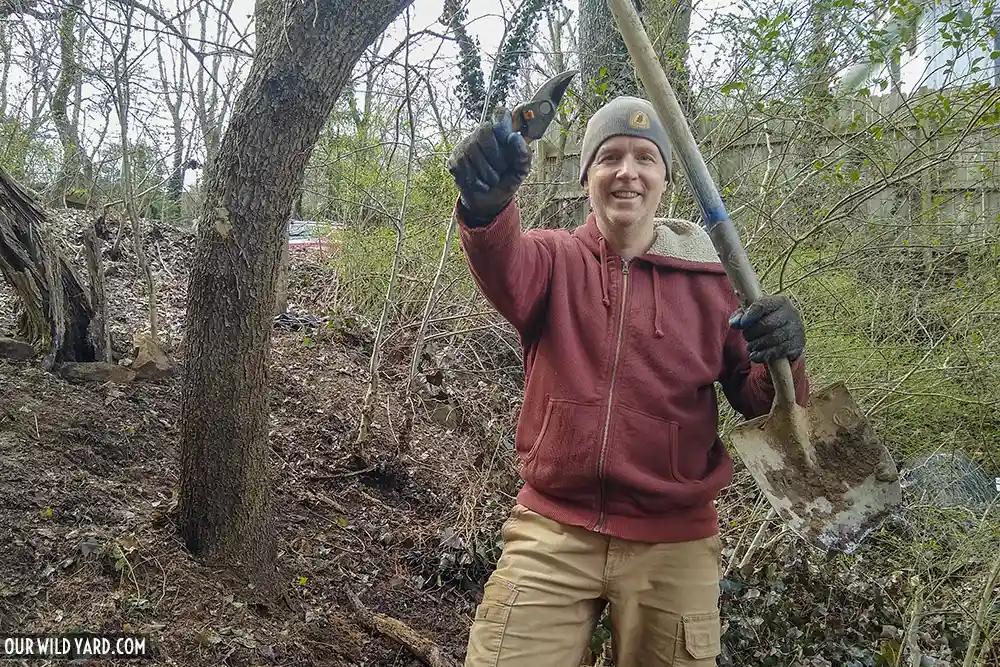
De-vine intervention: good news and bad news for the ivy killer
The first thing you have to accept is that killing English ivy is hard work and requires follow-up. That’s the bad news. The good news is that, compared to some other invasive vines that drive me crazy, English ivy is easy to cut through with hand clippers and the root system is relatively shallow and easy to pull out.
How to kill English ivy step-by-step
1. Work downhill and peel like a carpet
If you have a serious mat like we have, the best way to remove English ivy is to peel it back like a carpet. If your yard slopes, start at the highest point. It’s just easier to roll it downhill.
2. Remove logs branches etc from the ground
English ivy grows through and over everything on the ground creating a tangled mess. If there are sticks, branches, logs, lumber, or any trash mixed in, peeling up the ivy becomes impossible. Even worse, it may prevent you from pulling the roots. One of the first things you need to do is take the time to remove sticks, branches, and logs.
3. Work in small patches
English ivy creates a lot of biomass and it gets heavy. I try to select an area about 64 square feet (8 ft by 8 ft) that I can remove in a single mass, and will be light enough for me to carry in a ball to a discard pile for decomposition.
4. Start clipping edges, aim for obstacles
Clip through vines to create the two edges of your peel. Ideally, aim those edges toward obstacles like trees or bushes so you can peel around either side of them. The easiest and fastest method I’ve found for this is to start at the top edge of the patch, face downhill, and dig my boot under the ivy stems along the line I want to cut. Lift up the mass of vines with your gloved hand and clip through them. Repeat. Either kick deep or rake the ground with your fingers because runners are sometimes hiding just under the soil surface.
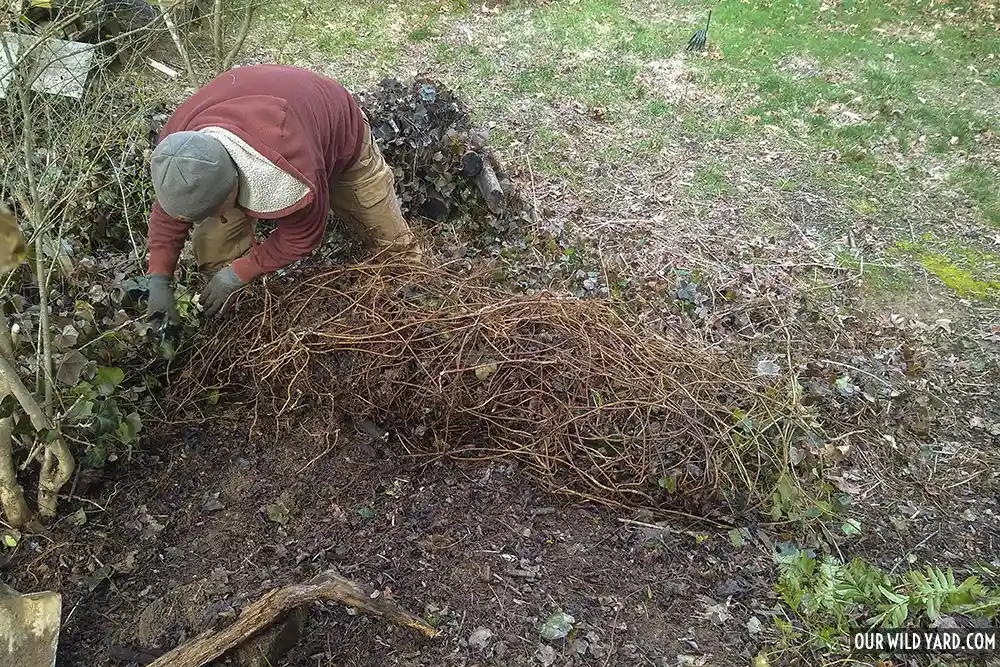
5. Pull roots
Once you’ve clipped the two sides, start peeling from the top downward. As you lift, you’ll start to discover vines rooted to the ground. Grab firmly where it enters the ground and pull upward. If it resists, wrap it once around your hand and pull harder. Most of the time, some or all of the root pops out of the ground with this technique. But if you don’t get the whole thing, don’t despair and keep moving. Just get as many as you can. Also peel vines off of tree bark to make sure your trees are clear.
6. Dig out larger roots
If you find an unusually fat root and it doesn’t pull out by hand, now is the time to grab your shovel and dig it out. These grand-daddy roots may be some of the original plants. At this point I can’t help but think of the person who planted it there so long ago and I curse them for the years of torture they have caused me.
7. Follow up the next year
This step is critical so don’t leave it out. You won’t get every root. But if you keep an eye on the area, any new growth that pops out the following winter is a root that survived. When you spot new leaves, it’s time to get out the shovel and make sure you get that bugger out.
How to kill ivy: what works and what doesn’t work
What doesn’t work? Just clipping the ivy back. English ivy will simply laugh in your face and grow even faster to spite you. If you have English ivy growing around large trees I have some bad news for you. You might not be able to get out all the ivy roots growing under the base of the tree and you may be doomed to a life of repeated control. I have a section of my yard where this happens. I’m getting angry just thinking about it so let’s move on. What does work? We’ve had our best results following the above steps and then visiting the site regularly to catch stragglers. In a period of about two years you may find your yard ivy free! I have successfully achieved this in a patch of open woods in my yard that was once knee deep in ivy. We now refer to it as “the happy place”. Soak it in and revel in your accomplishment my friends.
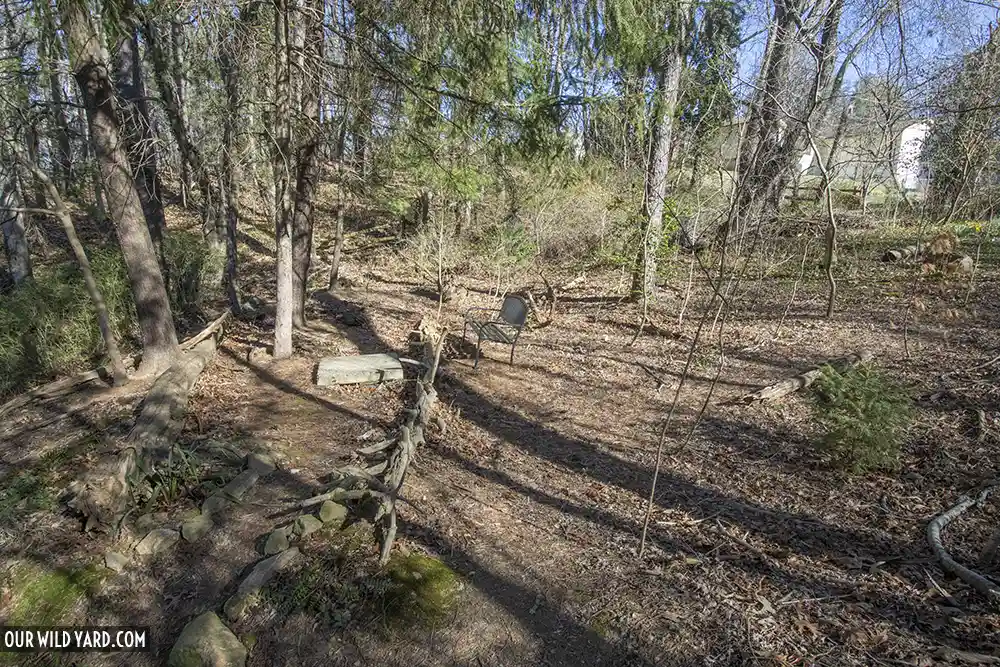
The aftermath: what’s next?
Once you’ve removed a thick mat of English ivy you’ll find nothing but bare dirt beneath. Not a leaf, plant, twig, insect, or creature: a biological desert. I find shockingly few things sheltering in English ivy. I’ve just spent 4 days in late February pulling ivy and haven’t discovered a single cocoon, larvae, salamander, snake, turtle, small mammal, rabbit or bear sheltering inside it. While it may look like excellent cover, I find that virtually nobody uses it. So now that it’s gone, it’s time to re-mulch this land and protect the soil.
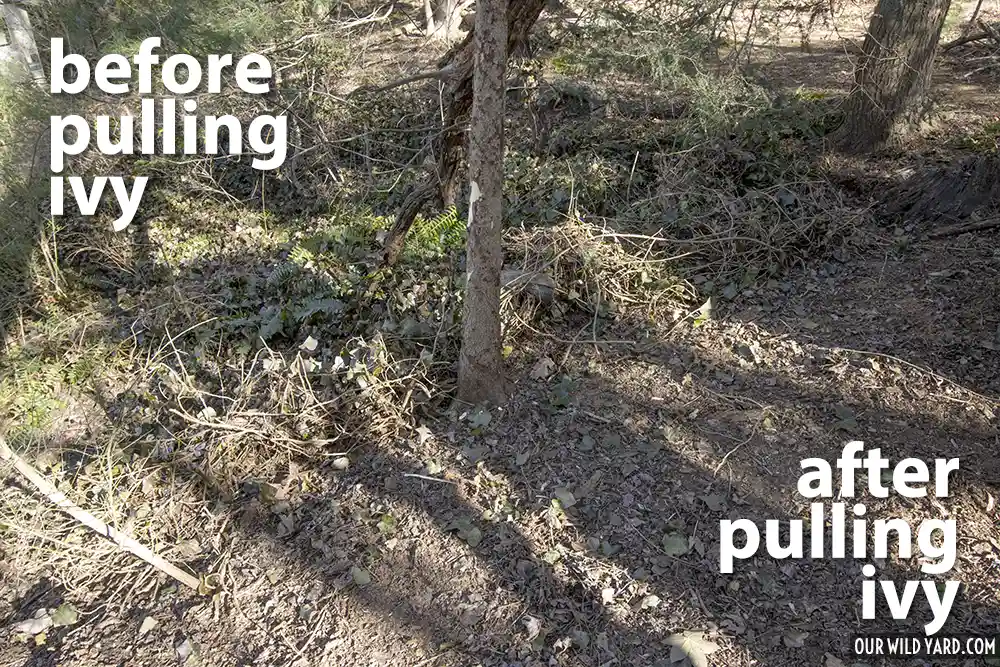
In the eastern US we are primarily in a forest habitat so leaves are what you need. Working in late winter, I usually still have piles of dead leaves around from the end of fall so I rake them up from driveways and pathways and redistribute them to the bare earth. I also pile up all the dead ivy vines and let it decompose for several months or years before redistributing all that nice biomass back to the soil. Finally I randomly redistribute twigs, branches and logs across the leaves. This gives funguses a place to grow, gives small creatures a place to shelter, and the rotting matter improves the soil. Now you have a clean slate for planting native ground cover, woodland flowers, shrubs & small trees!
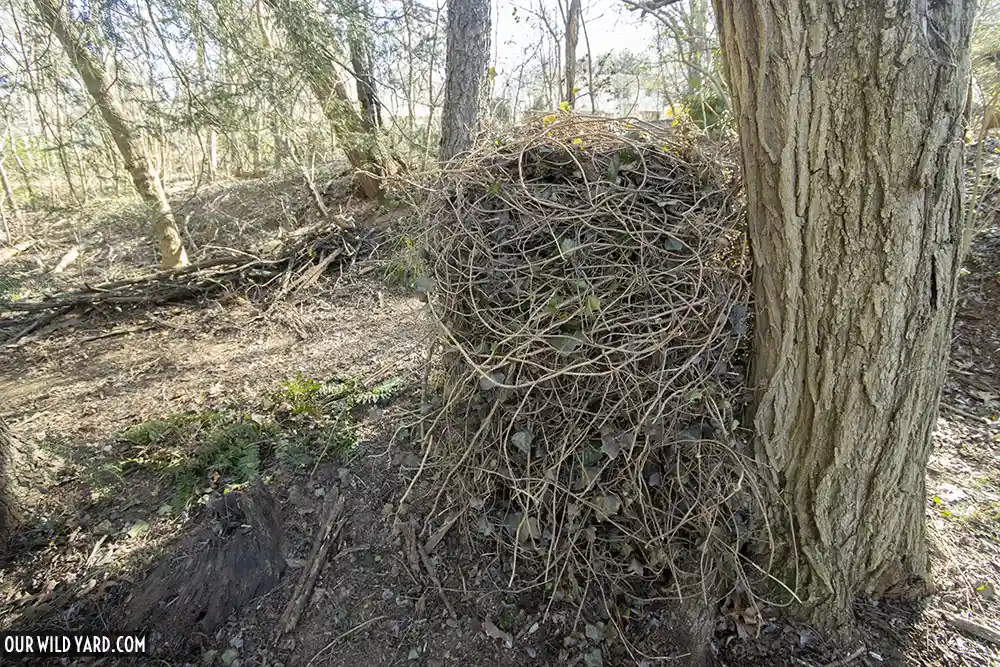
You can do it
Don’t despair. You can do this. I know sometimes you want to throw your hands up and poison the hell out of the place with a chemical treatment. But it is possible to control and even get rid of English ivy with a bit of determination. But how do we keep others from suffering the same fate?
Spread the word
In my opinion it should be illegal to sell English ivy in the United States (along with any other dangerously invasive plants). If I could go back in time I would find the person who planted English ivy in my yard and hand them a bill for all the hours of my life wasted removing it and for all the plants they’ve killed in the process. But since that’s not likely to happen, let’s instead gently discourage people from planting this impressively pernicious vine and save future generations from cursing us.
(A note about ivy species)
There are in fact a few species of ivy commonly referred to as English ivy. Hedera helix is probably the most common and the one most correctly termed English ivy, though it is sometimes referred to as Common Ivy. But another closely related species, Hedera hibernica, (common name Atlantic or Irish Ivy) tends to be prevalent in the western US and may be even more aggressively invasive. Each has a slightly different leaf shape and size as well as slightly different habitat preferences. (If you’re interested you can read a bit more about species here.) Boston ivy is a similar looking non-native species (actually native to Asia) but is somewhat less invasive and sheds its leaves in winter. The similar looking Virginia creeper is native and not invasive in the United States, so if you want a decorative climbing vine that won’t destroy everything, check that one out!

I am so sorry for your pain. In my twenties we bought some land and I planted English ivy. I kelp it trimmed but my husband and I divorced and I gave him the house. 40 yrs later and it’s gone wild. I guess I have a job trying to get rid of it
Thanks Denise and I wish the best of luck!
I had a horrible invasion of ivy in my backyard that I inherited from the previous homeowner. We are talking roots as big as my forearm. I am not exaggerating. It was an area of about 100 ft x 10 ft solid mass that had engulfed all the trees. Its removal was beyond me. I paid this spring a small fortune for a landscaping company to come in and rip it out. But I still have roots, and nasty little sprouts that taunt me forcing me onto my knees to wrest them from the earth. Today, my arms and face (don’t touch your face) are covered in a horrible, itchy rash from grasping the ivy regrowth and anything resembling a weed or vine. I am headed to a horrible store to purchase anti-itch meds and the alleged holy triad for ivy murder: vinegar, dish soap, and salt. Wish me well. I do not want to use poisonous chemicals, but I will. Stop the ivy. It is evil.
Hi Tanya,
Sorry to hear about your horrible invasion! I also find that poison ivy mixes in with my English ivy patches so if I don’t cover up carefully I always end up with some poison ivy rash myself. That’s why I like to work in February, because the poison ivy hasn’t leafed out and and I can bundle up in several protective layers without sweating! Best of luck with your project! -Hal
I am allergic to English Ivy too. It is terrible, but not as bad as poison ivy. Regular antihistamines before you go out there. I cough, sneeze, and get a scratchy rash that lasts for a couple of days. Try not to let the vines weep onto your skin. That is key. But there is not much you can do (unless you wear a mask) to avoid the pollen from it. Good luck!
This is the exact method I have used to get rid of the ivy in my woods!! It took me a year and a half to finish.
But I worry about it creeping back from the other side.
Have you ever tried covering patches of it with a weed cover?
Hi Chasity, No I’ve never tried using weed cover. This pulling (and follow up) method has worked well for me in open patches but when it has woven its way through stone walls or under tree roots, it just doesn’t cut it. I’ve considered poison in these situations but still haven’t tried it. And yes, reinvasion from neighboring sites is bound to occur. It never ends! I wish you the best of luck with yours. -Hal
Iam going to embark on removing a large cover of English Ivy.
I was considering getting wood chips to put down after the ivy removal. Would this be something that would work? The ivy is on a hill and I am worried about erosion.
Kathryn, I think some kind of mulch (like wood chips) is useful after an ivy removal because the heavily-disturbed bare soil can be very encouraging for other invasives to move in. If it is in a forest environment, I prefer a more natural forest floor mulch (leaf litter and twigs) because it supports insects and creatures who depend on leaf litter. If you are making a more formal or semi-formal landscaping area, then wood chips will certainly help prevent erosion and weedy intrusion. Best case scenario is to get other native plants growing on the slope to prevent erosion. Good luck to you on your project!
Thank you so much for this excellent article and all the follow-up. It’s late winter, and I am going to do the manual removal. I will use leaves/lead mould (partially decomposed leaves) to cover what I expose. I also will add in some twigs. I agree about the bark not being ideal to create a healthy, living substrate. Thanks so much!
Hi Kathryn,
I’m planning to do the same in our yard. I think the previous owners likely planted it to have a ground cover on the slope but like you, worry about erosion after removal. I’ll be staying tuned to how it works out for you so hope you’ll keep us posted. Good luck!
Hi Kelley,
I will let you know. I ended up mowing it down all last summer in preparation. Now there is a bit of snow on the ground but as soon as I can I will get out there and simply dig up as much as I can. I left leaves on the ground over it and will take them aside then replace them once I finish a section. I will be putting in some small native shrubs instead of another ground cover and let leaves be my mulch. I’m glad you’re going to tackle your slope too. Good luck!
You can get a shredder. It looks like a blower, but works in reverse, sucking up leaves and shredding them to make mulch. Costs around $100
As I battle various invasive species in our yard, I was so happy to find some laughter in our shared struggles. I’m looking forward to late winter so I can start really tackling our ivy problem. Thanks so much for the advice and encouragement!
Thank you Kelley! Best of luck with your “de-vine intervention”!
Hi There,
You and me have a very similar process, but with one difference, probably due to the different habitats we work in. My redwood forest on coastal California has similar invasion problems. However, when I remove the ivy, the natural flora is quick to recover. I generally have to do nothing to reestablish the original plant herbaceous cover that is natural and native to the redwood forest floor. It makes pulling ivy really rewarding. I mention it here, since others will read this blog as well.
That’s great to know Ann! How lucky you are! Best of luck with your ivy adventures. -Hal
Ann, I don’t know if you will read this. But if you do, would you please tell me what plants are in the category of “original plant herbaceous cover” ?
I have a few old redwoods, surrounded by English Ivy that are slowly killing the redwoods (one arborist told me the ivy was preventing 2 redwoods from accessing enough water). I will be removing the English ivy soon, but I want to also proactively plant something else there…preferably native ground cover. At the very least, something non-invasive, hardy and with low water consumption. I am in zone 10, with coastal redwoods.
#3 above talks about defining an area so it doesn’t get too heavy to roll. Are you recommending a 2’x8′ area (16 sq ft) or an 8’x8′ area (64 sq ft)?
I plan on teaching this so would be helpful.
Cheers!
Hi Julie, I aim for around an 8×8 area of ivy at a time. But I recommend you base it on how large a bundle you can carry at once off to your composting area.
I have a step hillside that is overrun with English ivy and poison ivy. It is steep enough that I can’t work on it standing up; I have to scoot up and down the hill on my backside. It is big enough that I can’t get the whole thing cleared at once, and if course, all my hard work gets covered up again. I’m going to try the rolling method this spring, but if you have any other suggestions, please feel free to share. After years of battling this stuff, along with not getting any younger, I’m beginning to feel defeated!